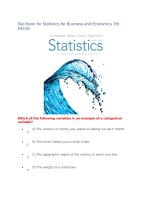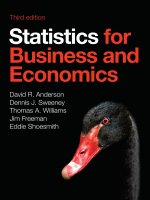Statistics for business economics 7th by paul newbold chapter 10
Bạn đang xem bản rút gọn của tài liệu. Xem và tải ngay bản đầy đủ của tài liệu tại đây (231.63 KB, 42 trang )
Statistics for
Business and Economics
7th Edition
Chapter 10
Hypothesis Testing:
Additional Topics
Copyright © 2010 Pearson Education, Inc. Publishing as Prentice Hall
Ch. 10-1
Chapter Goals
After completing this chapter, you should be able to:
Test hypotheses for the difference between two population means
Two means, matched pairs
Independent populations, population variances known
Independent populations, population variances unknown but
equal
Complete a hypothesis test for the difference between two
proportions (large samples)
Use the chi-square distribution for tests of the variance of a normal
distribution
Use the F table to find critical F values
Complete an F test for the equality of two variances
Copyright © 2010 Pearson Education, Inc. Publishing as Prentice Hall
Ch. 10-2
Two Sample Tests
Two Sample Tests
Population
Means,
Dependent
Samples
Population
Means,
Independent
Samples
Population
Proportions
Population
Variances
Examples:
Same group
before vs. after
treatment
Group 1 vs.
independent
Group 2
Copyright © 2010 Pearson Education, Inc. Publishing as Prentice Hall
Proportion 1 vs.
Proportion 2
Variance 1 vs.
Variance 2
Ch. 10-3
10.1
Dependent Samples
Tests Means of 2 Related Populations
Dependent
Samples
Paired or matched samples
Repeated measures (before/after)
Use difference between paired values:
di = x i - y i
Assumptions:
Both Populations Are Normally Distributed
Copyright © 2010 Pearson Education, Inc. Publishing as Prentice Hall
Ch. 10-4
Test Statistic:
Dependent Samples
The test statistic for the mean difference is a t value, with
n – 1 degrees of freedom:
Dependent
Samples
where
d D0
t
sd
n
d
d
n
i
x y
D0 = hypothesized mean difference
sd = sample standard dev. of differences
n = the sample size (number of pairs)
Copyright © 2010 Pearson Education, Inc. Publishing as Prentice Hall
Ch. 10-5
Decision Rules: Matched Pairs
Matched or Paired Samples
Lower-tail test:
Upper-tail test:
Two-tail test:
H0: μx – μy 0
H1: μx – μy < 0
H0: μx – μy ≤ 0
H1: μx – μy > 0
H0: μx – μy = 0
H1: μx – μy ≠ 0
-t
t
Reject H0 if t < -tn-1,
Where
Reject H0 if t > tn-1,
t
d D0
sd
n
/2
-t/2
/2
t/2
Reject H0 if t < -tn-1 ,
or t
> tn-1 ,
has n - 1 d.f.
Copyright © 2010 Pearson Education, Inc. Publishing as Prentice Hall
Ch. 10-6
Matched Pairs Example
Assume you send your salespeople to a “customer
service” training workshop. Has the training made a
difference in the number of complaints? You collect
the following data:
di
d = n
Number of Complaints:
(2) - (1)
Salesperson
C.B.
T.F.
M.H.
R.K.
M.O.
Before (1)
6
20
3
0
4
After (2)
4
6
2
0
0
Copyright © 2010 Pearson Education, Inc. Publishing as Prentice Hall
Difference, di
- 2
-14
- 1
0
- 4
-21
= - 4.2
Sd
2
(d
d
)
i
n 1
5.67
Ch. 10-7
Matched Pairs: Solution
Has the training made a difference in the number of
complaints (at the = 0.05 level)?
H0: μx – μy = 0
H1: μx – μy
0
= .05
d = - 4.2
Critical Value = ± 2.776
d.f. = n − 1 = 4
Test Statistic:
d D0 4.2 0
t
1.66
sd / n 5.67/ 5
Copyright © 2010 Pearson Education, Inc. Publishing as Prentice Hall
Reject
Reject
/2
/2
- 2.776
2.776
- 1.66
Decision: Do not reject H0
(t stat is not in the reject region)
Conclusion: There is not a
significant change in the
number of complaints.
Ch. 10-8
10.2
Difference Between Two Means
Population means,
independent
samples
Goal: Form a confidence interval
for the difference between two
population means, μx – μy
Different populations
Unrelated
Independent
Sample selected from one population has no effect on the
sample selected from the other population
Normally distributed
Copyright © 2010 Pearson Education, Inc. Publishing as Prentice Hall
Ch. 10-9
Difference Between Two Means
(continued)
Population means,
independent
samples
σx2 and σy2 known
Test statistic is a z value
σx2 and σy2 unknown
σx2 and σy2
assumed equal
σx2 and σy2
assumed unequal
Copyright © 2010 Pearson Education, Inc. Publishing as Prentice Hall
Test statistic is a a value from the
Student’s t distribution
Ch. 10-10
σx2 and σy2 Known
Population means,
independent
samples
σx2 and σy2 known
Assumptions:
*
Samples are randomly and
independently drawn
both population distributions
are normal
Population variances are
known
σx2 and σy2 unknown
Copyright © 2010 Pearson Education, Inc. Publishing as Prentice Hall
Ch. 10-11
σx2 and σy2 Known
(continued)
When σx2 and σy2 are known and
both populations are normal, the
variance of X – Y is
Population means,
independent
samples
2
σx2 and σy2 known
σx2 and σy2 unknown
σ 2X Y
*
2
σy
σx
nx
ny
…and the random variable
Z
(x y) (μX μY )
2
σ 2x σ y
nX nY
has a standard normal distribution
Copyright © 2010 Pearson Education, Inc. Publishing as Prentice Hall
Ch. 10-12
Test Statistic,
σx2 and σy2 Known
H0 : μx μy D0
Population means,
independent
samples
σx2 and σy2 known
*
σx2 and σy2 unknown
The test statistic for
μx – μy is:
x y D0
z
2
2
σy
σx
nx
ny
Copyright © 2010 Pearson Education, Inc. Publishing as Prentice Hall
Ch. 10-13
Hypothesis Tests for
Two Population Means
Two Population Means, Independent Samples
Lower-tail test:
Upper-tail test:
Two-tail test:
H0: μx μy
H1: μx < μy
H0: μx ≤ μy
H1: μx > μy
H0: μx = μy
H1: μx ≠ μy
i.e.,
i.e.,
i.e.,
H0: μx – μy 0
H1: μx – μy < 0
H0: μx – μy ≤ 0
H1: μx – μy > 0
H0: μx – μy = 0
H1: μx – μy ≠ 0
Copyright © 2010 Pearson Education, Inc. Publishing as Prentice Hall
Ch. 10-14
Decision Rules
Two Population Means, Independent Samples,
Variances Known
Lower-tail test:
Upper-tail test:
Two-tail test:
H0: μx – μy 0
H1: μx – μy < 0
H0: μx – μy ≤ 0
H1: μx – μy > 0
H0: μx – μy = 0
H1: μx – μy ≠ 0
-z
Reject H0 if z < -z
z
Reject H0 if z > z
Copyright © 2010 Pearson Education, Inc. Publishing as Prentice Hall
/2
-z/2
/2
z/2
Reject H0 if z < -z/2
or z
> z/2
Ch. 10-15
σx2 and σy2 Unknown,
Assumed Equal
Assumptions:
Population means,
independent
samples
σx2 and σy2 known
Samples are randomly and
independently drawn
Populations are normally
distributed
Population variances are
unknown but assumed equal
σx2 and σy2 unknown
σx2 and σy2
assumed equal
*
σx2 and σy2
assumed unequal
Copyright © 2010 Pearson Education, Inc. Publishing as Prentice Hall
Ch. 10-16
σx2 and σy2 Unknown,
Assumed Equal
(continued)
Population means,
independent
samples
The population variances
are assumed equal, so use
the two sample standard
deviations and pool them to
estimate σ
use a t value with
(nx + ny – 2) degrees of
freedom
σx2 and σy2 known
σx2 and σy2 unknown
σx2 and σy2
assumed equal
*
σx2 and σy2
assumed unequal
Copyright © 2010 Pearson Education, Inc. Publishing as Prentice Hall
Ch. 10-17
Test Statistic,
σx2 and σy2 Unknown, Equal
The test statistic for
μx – μy is:
σx2 and σy2 unknown
σx2 and σy2
assumed equal
*
σx2 and σy2
assumed unequal
t
x y μx μy
2
p
2
p
s
s
nx ny
Where t has (n1 + n2 – 2) d.f.,
and
sp2
Copyright © 2010 Pearson Education, Inc. Publishing as Prentice Hall
(nx 1)s2x (ny 1)s2y
nx ny 2
Ch. 10-18
Decision Rules
Two Population Means, Independent Samples,
Variances Unknown
Lower-tail test:
Upper-tail test:
Two-tail test:
H0: μx – μy 0
H1: μx – μy < 0
H0: μx – μy ≤ 0
H1: μx – μy > 0
H0: μx – μy = 0
H1: μx – μy ≠ 0
-t
Reject H0 if
t < -t (n1+n2 – 2),
t
Reject H0 if
t > t (n1+n2 – 2),
Copyright © 2010 Pearson Education, Inc. Publishing as Prentice Hall
/2
-t/2
/2
t/2
Reject H0 if
t < -t (n1+n2 – 2), or
t > t (n1+n2 – 2),
Ch. 10-19
Pooled Variance t Test: Example
You are a financial analyst for a brokerage firm. Is there
a difference in dividend yield between stocks listed on the
NYSE & NASDAQ? You collect the following data:
NYSE
Number
21
Sample mean
3.27
Sample std dev 1.30
NASDAQ
25
2.53
1.16
Assuming both populations are
approximately normal with
equal variances, is
there a difference in average
yield ( = 0.05)?
Copyright © 2010 Pearson Education, Inc. Publishing as Prentice Hall
Ch. 10-20
Calculating the Test Statistic
The test statistic is:
X
t
1
X 2 μ1 μ2
1 1
S
n1 n2
2
p
3.27 2.53 0
1
1
1.5021
21 25
2
2
2
2
n
1
S
n
1
S
21
1
1.30
25
1
1.16
1
2
2
S2 1
p
(n1 1) (n2 1)
Copyright © 2010 Pearson Education, Inc. Publishing as Prentice Hall
(21 - 1) (25 1)
2.040
1.5021
Ch. 10-21
Solution
H0: μ1 - μ2 = 0 i.e. (μ1 = μ2)
Reject H0
Reject H0
H1: μ1 - μ2 ≠ 0 i.e. (μ1 ≠ μ2)
= 0.05
df = 21 + 25 − 2 = 44
Critical Values: t = ± 2.0154
Test Statistic:
3.27 2.53
t
2.040
1
1
1.5021
21 25
Copyright © 2010 Pearson Education, Inc. Publishing as Prentice Hall
.025
-2.0154
.025
0 2.0154
t
2.040
Decision:
Reject H0 at = 0.05
Conclusion:
There is evidence of a
difference in means.
Ch. 10-22
σx2 and σy2 Unknown,
Assumed Unequal
Assumptions:
Population means,
independent
samples
σx2 and σy2 known
Samples are randomly and
independently drawn
Populations are normally
distributed
Population variances are
unknown and assumed
unequal
σx2 and σy2 unknown
σx2 and σy2
assumed equal
σx2 and σy2
assumed unequal
*
Copyright © 2010 Pearson Education, Inc. Publishing as Prentice Hall
Ch. 10-23
σx2 and σy2 Unknown,
Assumed Unequal
(continued)
Forming interval estimates:
Population means,
independent
samples
The population variances are
assumed unequal, so a pooled
variance is not appropriate
use a t value with degrees
of freedom, where
σx2 and σy2 known
σx2 and σy2 unknown
2
σx2 and σy2
assumed equal
σx2 and σy2
assumed unequal
*
Copyright © 2010 Pearson Education, Inc. Publishing as Prentice Hall
s 2x
s 2y
( ) ( )
ny
nx
v
2
2
2
2
s
sx
/(nx 1) y /(ny 1)
n
nx
y
Ch. 10-24
Test Statistic,
σx2 and σy2 Unknown, Unequal
The test statistic for
μx – μy is:
σx2 and σy2 unknown
σx2 and σy2
assumed equal
σx2 and σy2
assumed unequal
*
t
(x y) D0
Where t has degrees of freedom:
Copyright © 2010 Pearson Education, Inc. Publishing as Prentice Hall
2
y
s
s
nX nY
2
x
v
s2x
s2y
( ) ( )
ny
nx
2
2
2
s2
s2x
/(nx 1) y /(ny 1)
n
nx
y
Ch. 10-25









